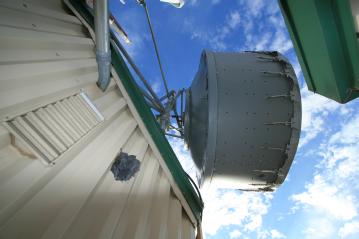|
January 7, 2008
HPWREN establishes its first OC3-capacity link
During the first week of January 2008, HPWREN established its
first OC3-capacity (about 155 megabits per second each direction
at full-duplex) wireless link across about 12 miles between the
Cuyamaca and Laguna mountains in San Diego County, which started
to pass production traffic immediately. It replaced previous
license-exempt radios with the new licensed connection, which finally
established the HPWREN loop between the coast and the mountains as
all-licensed.
The installation team included Pablo Bryant (San Diego State
University), Ron Serabia, Bud Hale, Jim Hale, and Hans-Werner Braun.
Jim Hale had the overall responsibility for the antenna installation
planning and execution.
 These images show the 8-foot ultra-high-performance antennas for
the two end-points of the wireless OC3 link. The image on the
right shows Pablo Bryant and Ron Serabia during the installation.
These images show the 8-foot ultra-high-performance antennas for
the two end-points of the wireless OC3 link. The image on the
right shows Pablo Bryant and Ron Serabia during the installation.
|

|
Besides replacing a remaining license-exempt link of the loop,
this is also the prototype for three more OC3-capacity links, to
replace existing DS3-capacity ones (about 45 megabits per second)
from the coast to the Palomar Observatory, which is driven by the
high traffic loads that the Palomar Observatory injects into the
HPWREN backbone. Those three segments are at distances of about 18,
22, and 29 miles. The Palomar Observatory is carrying a significant
fraction of the cost for the upgrade.
 back to top
back to top
 back to HPWREN news
back to HPWREN news |

